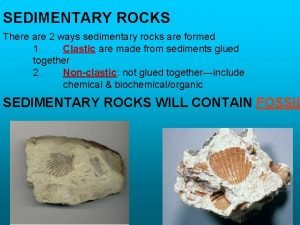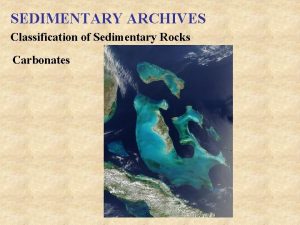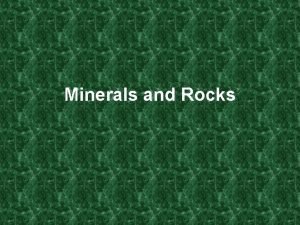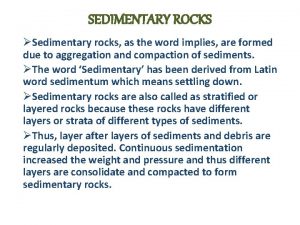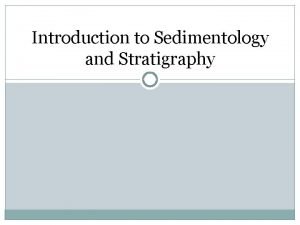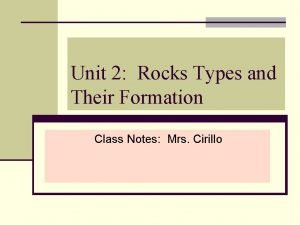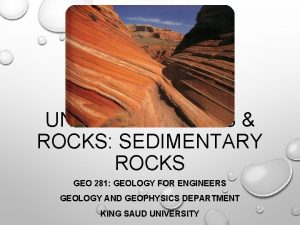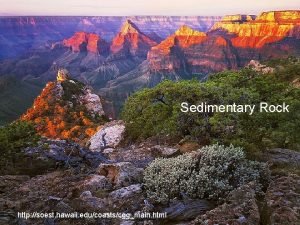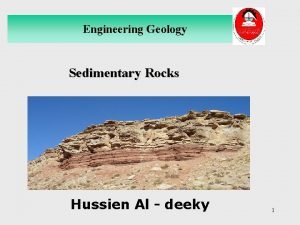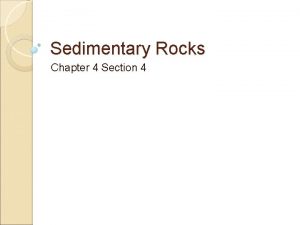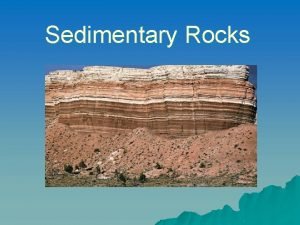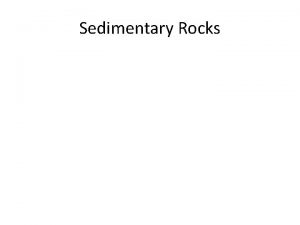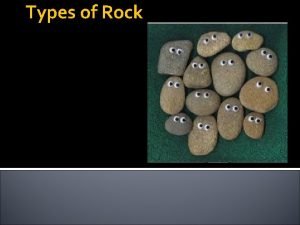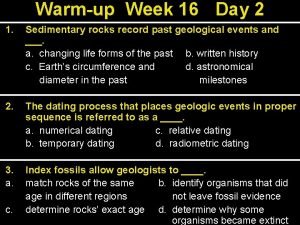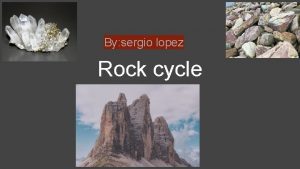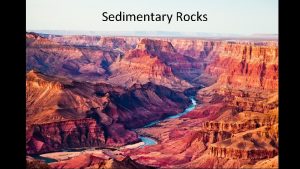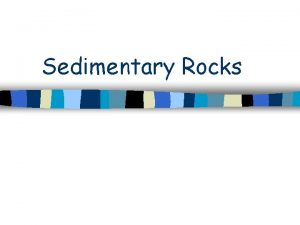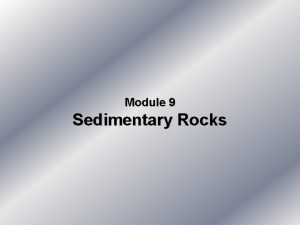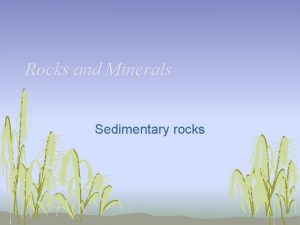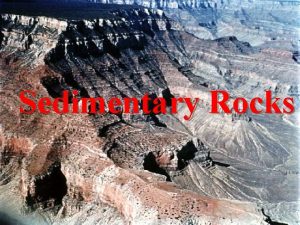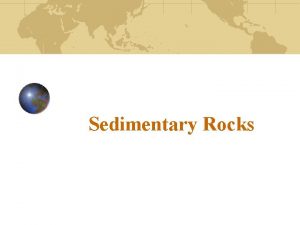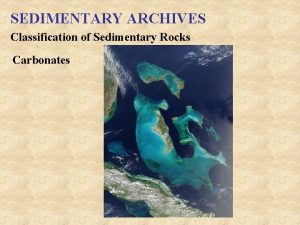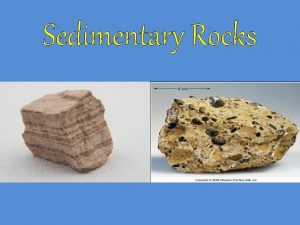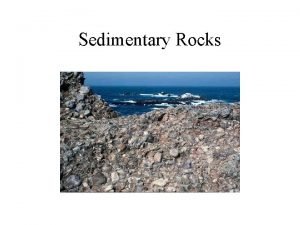Sedimentary Rocks Sedimentary Rocks l l l Products


























- Slides: 26

Sedimentary Rocks

Sedimentary Rocks l l l Products of mechanical and chemical weathering Account for about 5% of Earth’s crust Contain evidence of past environments s Texture s Fossils

Sedimentary Rocks Texture and composition - the keys to classification. Texture: Clastic or detrital Non-clastic Chemical (or crystalline) Biochemical

Sedimentary Rocks Clastic or detrital rocks are composed of particles of preexisting rocks which have been weathered, eroded, transported, deposited, and cemented together. Grain size (energy) Rounding - energy and length of transport Sorting - uniformity of grain size

Sedimentary Rocks Chemical sedimentary rocks: precipitated from solution. Texture also referred to as crystalline- readily recognized in moderately coarse-grained examples. Very fine-grained chemical rocks appear massive. Some limestone, halite, sulfates, etc. Evaporites are a common source. Also caves, hot springs.

Sedimentary Rocks Biochemical rocks: formed by the processes of organisms Calcite or silica shells or skeletons. Form directly (coral reefs) or Cemented together after organisms die & accumulate Energetic wave action may break up shells and produce clastic textures = clastic or biochemical? ? We'll consider it biochemical because the fragments are of biochemical origin If shell fragments are clearly recognizable, the texture is called skeletal

Sedimentary Rocks

Sedimentary Rocks Clastic/Detrital Rocks Shale- fine grained (mud, silt, clay) Fissile (splits in layers) Fissile Shale with leaf fossils Low-energy environment: Offshore shallow marine Lake

Sedimentary Rocks Clastic/Detrital Rocks Siltsone/mudstone- fine grained (mud, silt, clay) Massive- breaks in clumps Low-energy environment: Offshore shallow marine Lake Shale with leaf fossils Fissile Shale

Sedimentary Rocks Clastic/Detrital Rocks Sandstone- Composed of sand-sized particles Well-sorted: water or wind Forms in a variety of environments: beach, floodplain… Quartz is the predominant mineral Thin-section of sandstone under the petrographic microscope

Sedimentary Rocks Clastic/Detrital Rocks Graywacke “Immature” sandstone Contains lots of easily-weathered material: Mafic minerals, volcanic glass/ash Typically occurs in subsiding basin near an active volcanic arc (uplift/erosion and burial > chemical weathering)

Sedimentary Rocks Clastic/Detrital Rocks Conglomerate. Pebbles/cobbles Well-rounded: long transport High-energy environments: Beach, River

Sedimentary Rocks Clastic/Detrital Rocks Breccia. Pebbles/cobbles Poorly-rounded: short transport High-energy environments: Beach, River, Fault zone Breccia

Sedimentary Rocks Chemical Rocks Some Limestone is precipitated directly from water Also true for some dolostone (Ca-Mg-carbonate) and chert (Si. O 2)

Sedimentary Rocks Chemical Rocks Some Limestone is precipitated directly from water Travertine is typically precipitated from groundwater and is seen in caves Oolitic limestone contains small spherical ooids

Sedimentary Rocks Chemical Rocks Rock salt Evaporites are precipitated directly from seawater when a large quantity evaporates Rock Gypsum

Sedimentary Rocks Biochemical Rocks Most Limestone is organic: precipitated as shells, reefs, and even as tiny shells from planktonic life Fossiliferous Limestones

Sedimentary Rocks Biochemical Rocks Most Limestone is organic: precipitated as shells, reefs, and even as tiny shells from planktonic life Chalk fossils under electron microscope Limestone Reef Chalk Cliffs

Sedimentary Rocks Biochemical Rocks Coquina is composed of broken-up shell fragments due to marine wave action in the near-tidal zone It also qualifies as a detrital rock

Sedimentary Rocks Biochemical Rocks Chert, like chalk, is composed of tiny shells from planktonic life, but the organisms involved secrete Si. O 2 shells. Diatoms and radiolaria have microscopic Si. O 2 shells

Sedimentary Rocks Biochemical Rocks Coal is organic: buried and un-oxidized plant remains

Sedimentary Rocks Biochemical Rocks Coal is organic: buried and un-oxidized plant remains

Sedimentary Rocks Sedimentary Environments Using sedimentary rocks to interpret Earth history

Sedimentary Rocks Sedimentary Structures Large-scale cross-beds: wind-blown sands in an arid environment Many sedimentary structures may be used to determine original upward direction in vertical or overturned strata Ripple-marks: running water- beach or river Using sedimentary rocks to interpret Earth history

Sedimentary Rocks Sedimentary Structures Graded beds- offshore turbidites Using sedimentary rocks to interpret Earth history

Sedimentary Rocks Sedimentary Structures Mud-cracks and raindrop imprints Using sedimentary rocks to interpret Earth history
 Igneous vs metamorphic
Igneous vs metamorphic Igneous rocks metamorphic rocks and sedimentary rocks
Igneous rocks metamorphic rocks and sedimentary rocks How are sedimentary rocks formed
How are sedimentary rocks formed Sedimentary rocks
Sedimentary rocks How are sedimentary rocks formed
How are sedimentary rocks formed Luster of igneous rocks
Luster of igneous rocks Shale rock classification
Shale rock classification Sedimentary rocks
Sedimentary rocks Characteristic feature of sedimentary rocks
Characteristic feature of sedimentary rocks Sedimentary rock characteristics
Sedimentary rock characteristics Characteristics of sedimentary rocks
Characteristics of sedimentary rocks Characteristics of sedimentary rocks
Characteristics of sedimentary rocks What are sedimenta
What are sedimenta Esrt sedimentary rocks
Esrt sedimentary rocks Chemical sedimentary rocks formed
Chemical sedimentary rocks formed Sandstone
Sandstone A process that squeezes or compacts sediments
A process that squeezes or compacts sediments Fossils in sedimentary rocks
Fossils in sedimentary rocks Sedimentary rocks in hawaii
Sedimentary rocks in hawaii Sedimentary rock
Sedimentary rock Cementation sedimentary rocks
Cementation sedimentary rocks How are sedimentary rocks made
How are sedimentary rocks made Clastic
Clastic 3 main characteristics of metamorphic rocks
3 main characteristics of metamorphic rocks Non banded grains
Non banded grains Sedimentary rocks record past geological events and ____.
Sedimentary rocks record past geological events and ____. Facts on sedimentary rocks
Facts on sedimentary rocks



